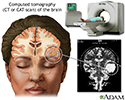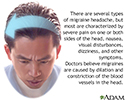Managing migraines at home
Headache - migraine - self-care; Vascular headache - self-careA migraine is a common type of headache. It may occur with symptoms such as nausea, vomiting, or sensitivity to light. Most people feel a throbbing pain on only one side of their head during a migraine.
Migraine
A migraine is a type of headache. It may occur with symptoms such as nausea, vomiting, or sensitivity to light and sound. In most people, a throbbi...

Some people who get migraines have warning signs, called an aura, before the actual headache begins. An aura is a group of symptoms that includes vision changes. An aura is a warning sign that a bad headache is coming.
Migraine headaches can be triggered by certain foods. The most common are:
- Any processed, fermented, pickled, or marinated foods, as well as foods that contain monosodium glutamate (MSG)
- Baked goods, chocolate, nuts, and dairy products
- Fruits (such as avocado, banana, and citrus fruit)
- Meats containing sodium nitrates, such as bacon, hot dogs, salami, and cured meats
- Red wine, aged cheese, smoked fish, chicken liver, figs, and certain beans
Alcohol, stress, hormonal changes, skipping meals, lack of sleep, certain odors or perfumes, loud noises or bright lights, exercise, and cigarette smoking may also trigger a migraine.
When You Get a Migraine
Try to treat your symptoms right away. This may help make the headache less severe. When migraine symptoms begin:
- Drink water to avoid dehydration, especially if you have vomited
- Rest in a quiet, dark room
- Place a cool cloth on your head
- Avoid smoking or drinking coffee or caffeinated drinks
- Avoid drinking alcoholic beverages
- Try to sleep
Over-the-counter pain medicines, such as acetaminophen, naproxen, ibuprofen, or aspirin, are often helpful when your migraine is mild. Be aware that aspirin and ibuprofen (Advil, Motrin) can irritate your stomach. If you take acetaminophen (Tylenol), do not take more than a total of 4,000 mg (4 grams) of acetaminophen a day to avoid liver damage. Taking acetaminophen with alcohol (3 or more drinks a day) also increases the risk of liver damage.
Your health care provider may have prescribed medicines to stop a migraine. These medicines come in different forms. They may come as a nasal spray, rectal suppository, or injection instead of pills. Other medicines can treat nausea and vomiting.
Follow your provider's instructions about how to take all of your medicines. Rebound headaches are headaches that keep coming back. They can occur from overuse of pain medicine. If you take pain medicine more than 3 days a week on a regular basis, you can develop rebound headaches.
Preventing Migraine Headaches
A headache diary can help you identify your headache triggers. When you get a headache, write down:
- Day and time the pain began
- What you ate and drank over the past 24 hours
- How much you slept
- What you were doing and where you were right before the pain started
- How long the headache lasted and what made it stop
Review your diary with your provider to identify triggers or a pattern to your headaches. This can help you and your provider create a treatment plan. Knowing your triggers can help you avoid them.
Lifestyle changes that may help include:
- Avoid triggers that seem to bring on a migraine headache.
- Get regular sleep and exercise.
- Slowly decrease the amount of caffeine you drink every day.
- Learn and practice stress management. Some people find relaxation exercises and meditation helpful.
Stress management
We all feel stress at one time or another. It's a normal and healthy reaction to change or a challenge. But stress that goes on for more than a few...
 ImageRead Article Now Book Mark Article
ImageRead Article Now Book Mark Article - Quit smoking and drinking alcohol.
If you have frequent migraines, your provider may prescribe medicine to reduce the number of them. You need to take this medicine every day for it to be effective. Your provider may have you try more than one medicine before deciding which works best for you.
When to Call the Doctor
Call 911 or the local emergency number if:
- You are experiencing "the worst headache of your life."
- You have speech, vision, or movement problems or loss of balance, especially if you have not had these symptoms with a headache before.
- You have a fever with your headache.
- A headache starts suddenly or is explosive in nature.
Schedule an appointment or contact your provider if:
- Your headache patterns or pain changes.
- Treatments that once worked are no longer help.
- You have side effects from your medicine.
- You are pregnant or could become pregnant. Some medicines should not be taken during pregnancy.
- You need to take pain medicines more than 3 days a week.
- You are taking birth control pills and have migraine headaches.
- Your headaches are more severe when lying down.
References
Digre KB. Headaches and other head pain. In: Goldman L, Cooney KA, eds. Goldman-Cecil Medicine. 27th ed. Philadelphia, PA: Elsevier; 2024:chap 367.
Garza I, Robertson CE, Smith JH, Whealy MA. Headache and other craniofacial pain. In: Jankovic J, Mazziotta JC, Pomeroy SL, Newman NJ, eds. Bradley and Daroff's Neurology in Clinical Practice. 8th ed. Philadelphia, PA: Elsevier; 2022:chap 102.
Waldman SD. Migraine headache. In: Waldman SD, ed. Atlas of Common Pain Syndromes. 5th ed. Philadelphia, PA: Elsevier; 2024:chap 2.
-
Migraine cause - illustration
One theory of the cause of migraine is a central nervous system (CNS) disorder. The CNS consists of the brain and spinal cord. In migraine, various stimuli may cause a series of neurologic and biochemical events which affect the brain's vascular system.
Migraine cause
illustration
-
CT scan of the brain - illustration
A CT or CAT scan (computed tomography) is a much more sensitive imaging technique than X-ray, allowing high definition not only of the bony structures, but of the soft tissues. Clear images of organs such as the brain, muscles, joint structures, veins and arteries, as well as anomalies like tumors and hemorrhages may be obtained with or without the injection of contrasting dye.
CT scan of the brain
illustration
-
Migraine headache - illustration
Symptoms of a migraine attack may include heightened sensitivity to light and sound, nausea, auras (loss of vision in one eye or tunnel vision), difficulty of speech and intense pain predominating on one side of the head.
Migraine headache
illustration
-
Migraine cause - illustration
One theory of the cause of migraine is a central nervous system (CNS) disorder. The CNS consists of the brain and spinal cord. In migraine, various stimuli may cause a series of neurologic and biochemical events which affect the brain's vascular system.
Migraine cause
illustration
-
CT scan of the brain - illustration
A CT or CAT scan (computed tomography) is a much more sensitive imaging technique than X-ray, allowing high definition not only of the bony structures, but of the soft tissues. Clear images of organs such as the brain, muscles, joint structures, veins and arteries, as well as anomalies like tumors and hemorrhages may be obtained with or without the injection of contrasting dye.
CT scan of the brain
illustration
-
Migraine headache - illustration
Symptoms of a migraine attack may include heightened sensitivity to light and sound, nausea, auras (loss of vision in one eye or tunnel vision), difficulty of speech and intense pain predominating on one side of the head.
Migraine headache
illustration
Review Date: 12/31/2023
Reviewed By: Joseph V. Campellone, MD, Department of Neurology, Cooper Medical School at Rowan University, Camden, NJ. Review provided by VeriMed Healthcare Network. Also reviewed by David C. Dugdale, MD, Medical Director, Brenda Conaway, Editorial Director, and the A.D.A.M. Editorial team.





